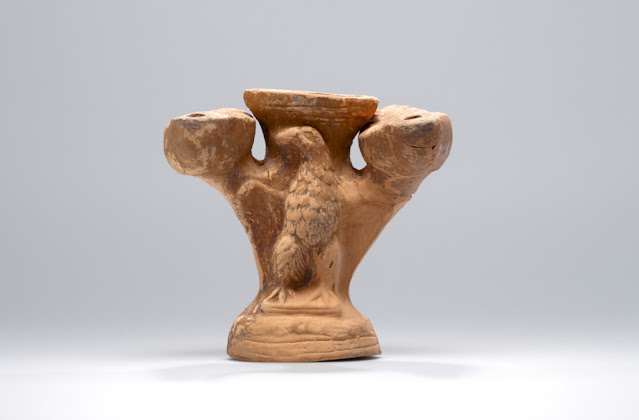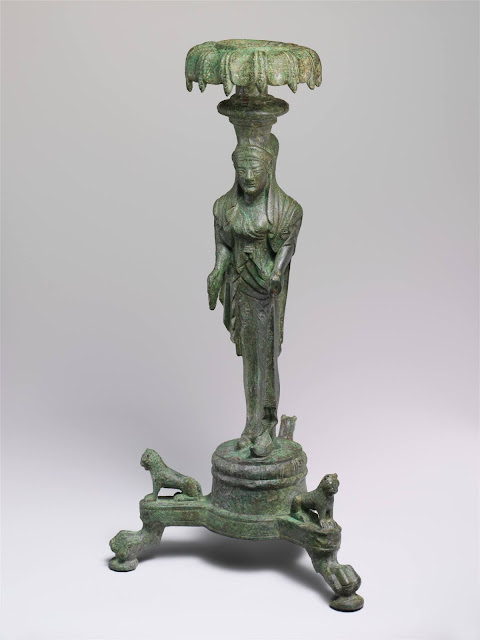The word incense comes from Latin incendere meaning 'to burn'. In ancient times incense was burnt to counteract or obscure malodorous products of human habitation, but was widely perceived to also deter malevolent demons and appease the gods with its pleasant aroma. Resin balls were found in many prehistoric Egyptian tombs in El Mahasna, giving evidence for the prominence of incense and related compounds in Egyptian antiquity. One of the oldest extant incense burners originates from the 5th dynasty of Egypt dating back to the 25th century BCE. The Babylonians also used incense while offering prayers to divining oracles and it is thought Incense spread from there to Greece and Rome.
Incense burners, commonly known in ancient Greece as thymiateria, could take a wide variety of forms, ranging from simple earthenware pots to elaborate carved, moulded or cast items made from clay or bronze. They were used in sacred rituals in sanctuaries and temples, during religious processions, funerals, symposiums and weddings.
The ritual use of thymiateria has been attested to in many archaeological sites including Olbia where a rich deposit of thymiateria has been found in the sanctuary of Aphrodite. These thymiateria were molded into a bust of the goddess but she is depicted as a modest matron and not nude as was typical for the goddess of love. The inclusion of Erotes is thought to provide an emphasis on her motherhood. They also distinguish the worshipped deity as Aphrodite and not Demeter, Hera or the Mother of the Gods as has been the case at other temple sites.
A Roman bronze thymiaterion in the form of a comic actor from the 1st century CE I have seen at the Getty Villa must have been used at dinner parties as I'm not familiar with any religious significance it may have. They also have a terracotta lamp/incense burner with an eagle with spread wings on it. I wonder if it was used for some military ritual?
"Although aroma was an essential part of thymiateria culture, only the Orphic Hymns cast light on the use of particular incenses (in pure form or in compound) for each god or hero," observes Maryna Rusiaieva in her paper "On Ancient Greek Thymiateria and Their Purpose."
For example, according to the Orphic Hymns, mánna is the recommended incense used to worship Artemis and Asclepius. It is obtained by evaporating the sap of the manna ash, extracted by making small cuts in the bark. Athena, on the other hand, prefers incense crafted from aromatic herbs. Dionysus, however, expects storax (sometimes marketed as styrax), a rare fragrant gum resin obtained from the Asian liquidambar tree. If you're planning a sea voyage, an offering of myrhh should be used to appeal to Poseidon.
The Orphic Hymns are a collection of eighty-seven hymns to the Olympian gods attributed to Orpheus, but the actual authorship is unclear. The date of composition of the hymns is also disputed. Scholars have dated the hymns to a period ranging from the 6th century BCE to the 4th century CE, although there is no evidence of any Christian influence in the poems.
You can learn much more about the Orphic Hymns here:
https://www.hellenicgods.org/projectstatement
The site provides the original Greek text and an English translation.
 |
| Silver Censer shaped like a bird, Byzantine, that I photographed at the Metropolitan Museum of Art in New York City |
 |
| Stand in the Shape of an Ibex that probably held an incense burner, Iran 1000-800 BCE, Bronze, that I photographed at the Walters Art Museum in Baltimore, Maryland. |
 |
| Frieze depicting two female temple attendants kneeling before an incense burner Roman 1st century CE Terracotta and slip that I photographed at the Art Institute of Chicago |
 |
| Feline-Handled Bronze Incense Burner, Parthian, 100 CE, at the Cleveland Museum of Art in Cleveland, Ohio, image courtesy of the museum and Wikimedia Commons. |
 |
| Incense Burner in the Form of a Female Head, probably representing Demeter, Greek, 3rd century BCE, found in Canosa, Italy, courtesy of the Walters Art Museum. |
 |
| Incense Burner (Thymiaterion) shaped as a Comic Actor Seated on an Altar Roman 1-50 CE Bronze and Silver at the Getty Villa in Pacific Palisades, California |
 |
| Moldmade terracotta lampstand/incense-burner from Central Anatolia, Roman, 1st century CE at the Getty Villa in Pacific Palisades, California. Image courtesy of the museum. |
 |
| Bronze southern Etruscan thymiaterion, 500 BCE, courtesy of Wikimedia Commons contributor Sailko. |
 |
| Bronze censer (thymiaterion), made in Paros, 460-450 BCE. Archaeological Museum of Delphi, courtesy of Wikimedia Commons contributor Dennis Jarvis. |





No comments:
Post a Comment